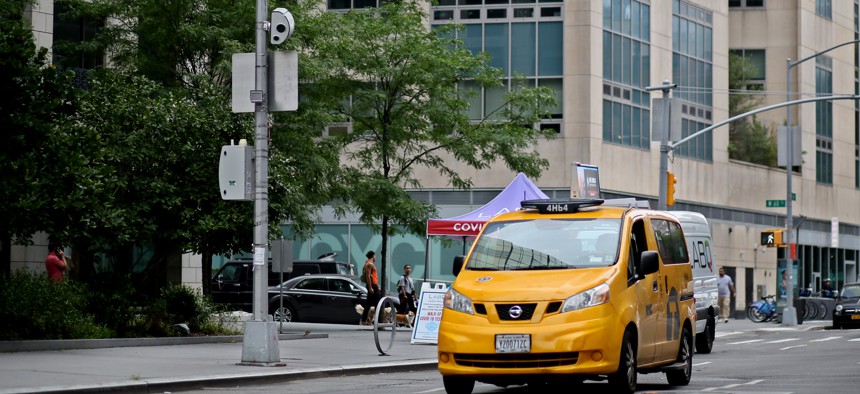As Traffic Deaths Surge, Report Says Cameras Are Needed

Speed cameras will be operational 24/7 in New York City as part of a program officials hope will reduce traffic fatalities. VIEW press via Getty Images
A traffic safety advocacy group also calls for restrictions on teen drivers in its 2023 Roadmap to Safety, which scores all 50 states on whether they have adopted the organization's "optimal laws."
State legislators should change traffic laws to make sure kids under the age of 12 sit in the back seat, to limit when teens can drive, and to allow for automated enforcement with speed and red-light cameras, a group of advocates said Tuesday.
The report from Advocates for Highway and Auto Safety comes as annual traffic deaths have surged to nearly 43,000, a number the group called “egregiously high.”
“Motor vehicle crash deaths have skyrocketed, and it is imperative that we utilize every opportunity to end this tragic toll,” wrote Cathy Chase, the group’s president, in the report.
Advocates found that only five states plus Washington, D.C., earned a “good” designation for traffic safety-related laws. The group looked at whether states enacted laws implementing 16 different policies. Those laws deal with occupant protection, child passenger safety, teen drivers, impaired drivers, distracted driving and automated enforcement.
Louisiana, Maryland, Oregon, Rhode Island, Washington state and Washington, D.C., earned a “good” rating from Advocates. Thirty-six states were in the group’s middle tier, labeled “caution.”
Nine states were on the bottom tier – Florida, Massachusetts, Michigan, Missouri, Montana, Nebraska, North Dakota, South Dakota and Wyoming.
California, Maine and New York dropped from the top tier, where they had been last year, because of updates made to the group’s criteria.
Some of the measures that Advocates called for have been widely adopted. For example, 46 states have banned drivers from sending text messages. Thirty-four allow for primary enforcement of seat belt laws for front-seat occupants, and 39 states ban open containers of alcohol in vehicles. In addition, 34 states also require people who have been convicted of driving under the influence to use an ignition interlock device.
But other Advocates’ recommendations were far less popular, particularly rules regarding teen drivers and child passengers. Of the group’s guidance:
- Only one state (New Jersey) went along with the group’s suggestion that learner’s permits should be restricted to people 16 or older, and full licenses limited to people 17 or older.
- Only one state (Maine) requires new teen drivers to have 70 hours of behind-the-wheel training with a licensed driver before they get their licenses, as Advocates recommends.
- Only two states (Idaho and South Carolina) prohibit teens from driving after 8 p.m.
- Seven states and the district restrict teen drivers from having young passengers with them who are not relatives.
- Only two states (Louisiana and Washington state) require all children 12 and under to sit in the back seat with seatbelts on.
- Just 17 states require children who have outgrown safety seats to use booster seats until they can properly use the built-in seatbelts (usually when the kids grow to 4 feet, 9 inches tall and are older than 8, according to Advocates).
- Eighteen states and the district require babies and toddlers to remain in rear-facing child seats until they are at least 2 years old.
One policy that Advocates did not include in its criteria was a requirement that teen drivers complete driver’s education courses.
“We have not seen any independent and verified research that shows that there’s a significant safety benefit to driver’s ed classes,” Chase told reporters. “But conversely, we do see great benefit from practicing behind the wheel, from limiting the number of other passengers while you’re in the intermediate phase and from not driving during the most dangerous times in the evening.”
The group added a new category of laws this year covering speed cameras and red-light cameras. They added the criteria as the number of speeding-related deaths has increased, and researchers have found that speed cameras can cut down on speed-related crashes.
Cameras have sparked backlashes in several state capitols for many reasons. Drivers complain that the cameras are being used to raise revenue rather than make streets safer. Motorists also balked at how red-light cameras judged infractions. A few camera vendors have been caught up in corruption scandals.
As a result, states take far different approaches toward automated enforcement. Eighteen states and the district use cameras to help enforce traffic laws. Five more allow for cameras, but don’t actually use them. And the remaining states ban traffic cameras altogether.






